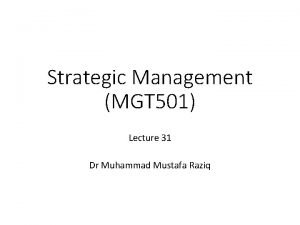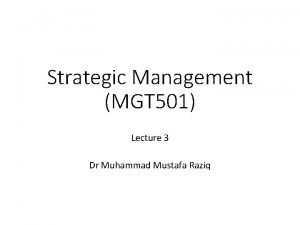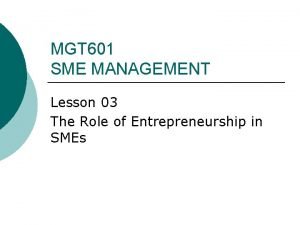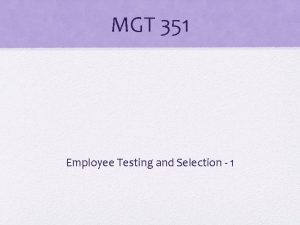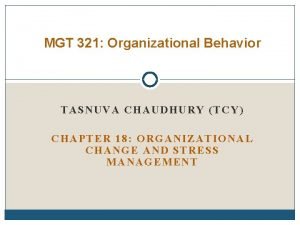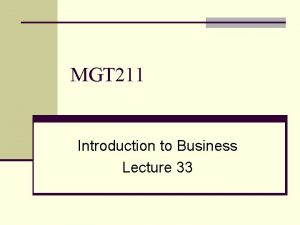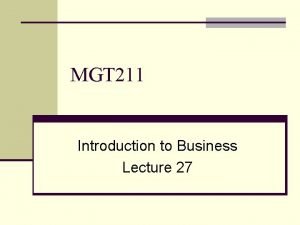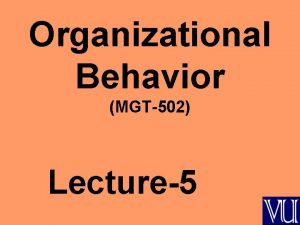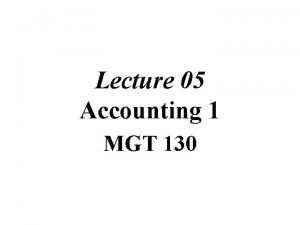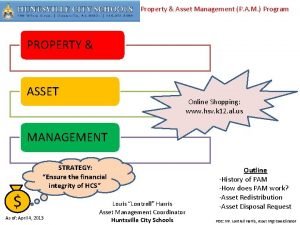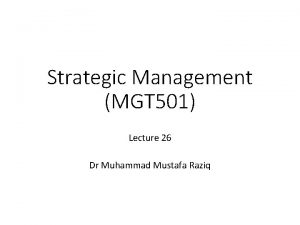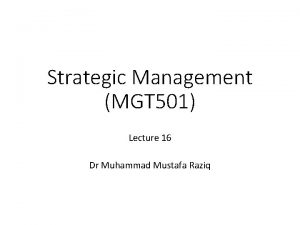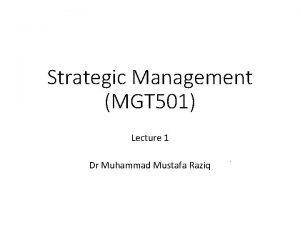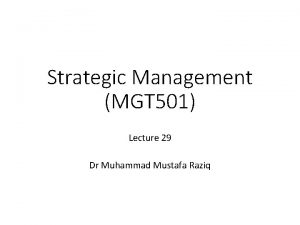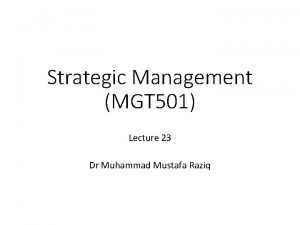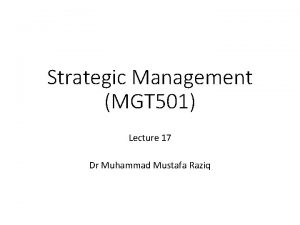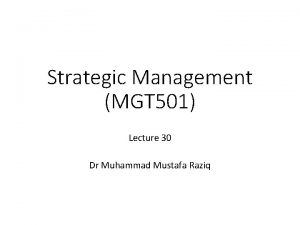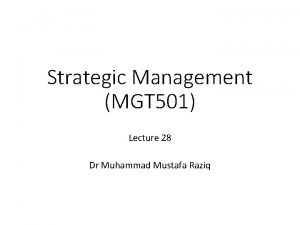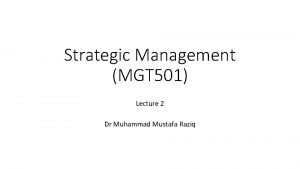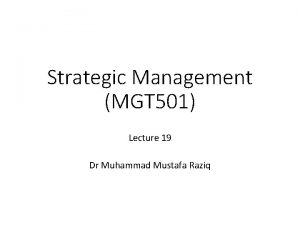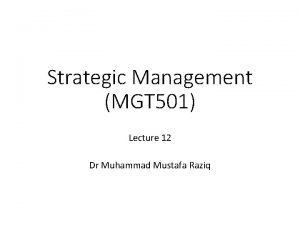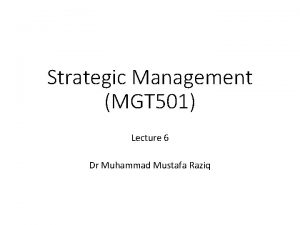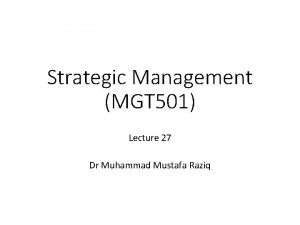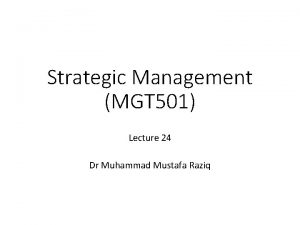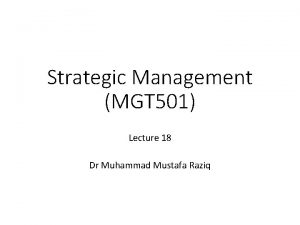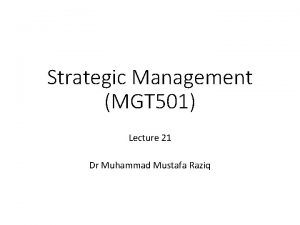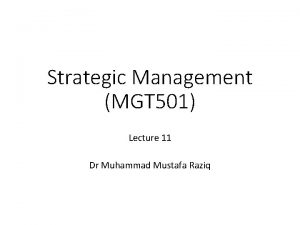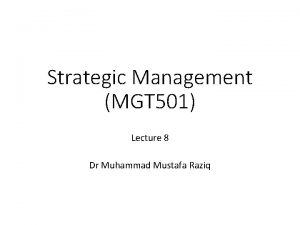Strategic Management MGT 501 Lecture 22 Dr Muhammad
























- Slides: 24

Strategic Management (MGT 501) Lecture 22 Dr Muhammad Mustafa Raziq

Topic Covered in the Previous Lecture • Strategies and Competitive Advantages in Diversified Companies and their Evaluation

Topics to be covered in this lecture • Diversification and Integration Strategies • Mergers, Acquisitions, and Takeover Strategies

6. 2. Diversification and Integration Strategies • A firm currently engaged in one type of activity proposing to enter into another type of business, with the expectation of adding further value to the whole firm, is said to be diversifying. • The main task of corporate level strategy is to identify businesses in which the firm would compete and decisions of allocating resources among diversified companies. • During the 1990 s, the issue of how to identify different businesses that should form a core portfolio for a corporation and how to add value to those businesses emerged, as the main issues of corporate strategy

6. 2. Diversification and Integration Strategies (continued) • According to Goold and Lukes (2008), the following three main alternative answers provide the basis for diversification • Diversification should be limited to those businesses with synergy • The corporate focus should be on exploiting core competences across different businesses • Successful diversification depends on building a portfolio of business that fits with the managerial ‘dominant logic’ of top executives and their management style • As the firm becomes diverse, the complexity increases making the task of corporate strategy challenging, and then strategically common methods and approaches can be used in businesses that are similar

6. 2. 1. Types of Diversifying Strategies • Diversification may be perceived in various ways as follows: • Diversification into vertical production chain activities extending vertical boundary of the firm, thus making a product than buying from the market • Horizontal diversification into new products or services that may be related or unrelated to the existing products or services • Diversification into new markets with existing and/or new products • Diversification into new technological fields • Diversification into new marketing methods or channels like web use • Diversification of in-house production into new production methods

6. 2. 2. Diversification opportunities • A firm looking for growth through diversification either comes across opportunities or looks for it. There are primarily two perspectives in seeking opportunities (Ter. Wiesch and Illrich 2008): • Flow of opportunities arrives as a result of the firm’s overall innovation process and the arrival of these opportunities is not triggered by the explicit need for them (push perspective) • Top managers identify gaps in the current portfolio relative to business strategy and want these gaps to be addresses (pull perspective)

6. 2. 3. Technological Diversification • It means expansion of a firm’s technology base into wide range of technology fields making the firm a multi -technology corporation • Firms sometimes acquire knowledge in different technological fields, not only in the field in which its products or services are embedded • When different technology fields share a similar underlying knowledge base, a firm’s technology portfolio is considered technologically coherent and when different knowledge domains support the technology fields within a field, the technology portfolio is technologically non-coherent

6. 2. 4. Parenting Advantage and Parenting Matrix • Multi-business companies comprise two elements: business ‘units’ and the ‘parent’. • The business units are directly involved in value creation by producing and selling goods and services whereas the parent is involved less directly and more as an intermediary between the businesses and outside investors • Example: Multinationals

6. 3. Mergers or Acquisitions • There are variety of ways firms expand through linkages between business units. These include merger, acquisition, joint ventures, and franchising. • This leads to achieving economies of scale – economies of scope is achieved through some combination of shared resources across two or more value chains, for example, sales force, trucks, marketing department, market research, advertising, Plant, Equipment, Labor Force, R&D (Kay 2007)

6. 3. 1. Mergers or Acquisition • A merger is a legal consolidation of two entities into one entity, whereas an acquisition occurs when one entity takes ownership of another entity's stock, equity interests or assets. • Generally there are four reasons for M&A’s (Haleblian 2009): • • Value creation Managerial factors, mostly self-interest Environmental factors Firm characteristics

6. 3. 1. Mergers or Acquisition (continued) • A firm may be in the lookout for targets to merge or acquire due to its strategy of expansion or diversification, environmental compulsions or manager’s self interest. Once the strategic decision is taken, the activity can be divided into four phases. • Pre-deal due diligence check phase • Deal negotiation and closing phase • Post-deal integration phase • Post-integration performance and/or merger repair phase • Each of these phases have its own required actions for a merger success. Right deal actions could be (Hernden 2008): • Conducted through due diligence (operations, finances, systems, people)

6. 3. 1. Mergers or Acquisition (continued) • Each of these phases have its own required actions for a merger success. Right deal actions could be (Hernden 2008): • Began the integration planning process before the deal closed • Assigned appropriate integration resources early and kept them available throughout the integration process • Chose the best top team • Aligned executives around the deal goals and strategy • Developed and executed detailed integration plans • Measured, tracked, and reported progress of implementation activities against the integration plans • Top executives made and communicated key decisions as integration progressed in an efficient, timely, and coordinated manner.

6. 3. 1. Mergers or Acquisition (continued) • Each of these phases have its own required actions for a merger success. Right deal actions could be (Hernden 2008): • Developed, tracked and reported balanced integration performance measures • Provided timely answers to workforce individual issues • Employed a retention and ‘re-recruitment’ plan to keep key talents • Put in place a process to efficiently and fairly staff the new company • Compared and integrated the companies cultures • Avoided using the phrases that can kill integration • Addressed all of the integration action items in each location • Began all of the integration action items within the first 12 months of closing the deal

6. 3. 1. Acquisition/Takeovers • Takeover is a method of purchase of a company called the target, by a firm called the acquirer or bidder by making an offer or bid. There are four types of takeovers: • Friendly: the process is an acquisition with or without due diligence check and transfer of shares and value, where both the shareholders and the board of the target firm agree to bid • Hostile: when the bid by an acquirer is rejected by the target company’s management. Even though the broad of management rejects the bid, the acquirer eventually gains control of the management of the target company, and thus, the takeover is effected in a hostile manner. The due diligence cannot be done and hence such takeovers have high risk

6. 3. 1. Acquisition/Takeovers • Takeover is a method of purchase of a company called the target, by a firm called the acquirer or bidder by making an offer or bid. There are four types of takeovers: • Hostile: there are several ways in which a hostile takeover is effected: • A publicly made tender offer above the current market price of the shares or firm’s valuation • The acquirer quietly purchases enough shares in the open stock market without regulator’s attention or notice • The acquirer persuades enough shareholders to get a majority to replace the existing management, and the new board will approve the takeover • Enter into a joint venture partnership with the target firm and gradually wrest control

6. 3. 1. Acquisition/Takeovers • Takeover is a method of purchase of a company called the target, by a firm called the acquirer or bidder by making an offer or bid. There are four types of takeovers: • Reverse: when a private company takes over a public company, it is called a reverse takeover • Backflip: when the acquiring firm becomes a subsidiary of the acquired firm, such a takeover is called backflip takeover • Takeovers are not always for profit, but for many other reasons and opportunities. It may be to get a distribution channel or technical knowhow or key talents or to eliminate competition.

6. 3. 2. Characteristics of Target Firms for Acquisition or Merger • The following are some of the common characteristics of many of the target firms. The presence of any or a few of these characteristics are likely to attract attention of acquiring firms with a bid for friendly or hostile acquisition: • Liquidity problems of high debts or bankruptcy • CEO change is contemplated or announced • Sharp fall in stock prices • Well entrenched and high growth in a particular emerging market • Possess strength on one or two brands in a few markets • Possess unique technology • Have favored access to unique raw materials • Low price-earning ratios

6. 3. 2. Characteristics of Target Firms for Acquisition or Merger (continued) • The following are some of the common characteristics of many of the target firms: • • • Low dividend payout Low growth in equity Growth-resource imbalance Inefficient management Asset under valuation Low leverage Magnitude of tax carry forwards Young companies with potential for future Firms in distributed industries Companies in newly unregulated sectors

6. 3. 2. Characteristics of Target Firms for Acquisition or Merger (continued) • However, it is not true to state that poor performance or small size is the real reason for attracting an acquirer, but the acquirer observes some complementarity of assets or identifies some hidden value or under-utilized assets.

6. 3. 3. Types of Merger • Horizontal mergers • Between firms in same business activity • Rationale • Economies of scale and scope • Synergies (ex. combining of best practices) • Government regulation due to potential anticompetitive effects • Vertical mergers: Combinations between firms at different stages - Goal is information and transaction efficiency. A manufacturer may decide to merge with a supplier of important components or raw materials, for example, or with a distributor or retailer that sells its products. • Conglomerate mergers • Firms in unrelated business activities

Mergers and Acquisitions (key points) • A merger is often viewed as a combination of two firms. An acquisition is viewed as one firm buying another. However, almost all mergers are essentially acquisitions. M&A can be synergistic or disciplinary or both. • Synergistic: To improve operational or financial synergies, e. g. , Exxon and Mobil - or to diversify by expanding into new businesses, e. g. , the AOL and Time Warner. Most of the recent mergers have occurred for growth and for increased market power, e. g. , Oracle and People. Soft, HP and Compaq. • Disciplinary: Takeovers are viewed as an important governance mechanism because some firms that get taken over are poorly performing firms. The fear of a potential takeover might represent a powerful disciplinary mechanism to make sure that: Managers perform to the best of their abilities; Managerial discretion is controlled.

Summary of the topics covered in this lecture • Diversification and Integration Strategies • Mergers, Acquisitions, and Takeover Strategies

Topics for the next lecture • Strategic Alliances • Joint Ventures Strategies • International Business Entry Level Strategies • Multinationals and Strategy
 Mgt 501
Mgt 501 Mgt 501
Mgt 501 Mgt 501
Mgt 501 الباح
الباح Pengertian puasa arafah
Pengertian puasa arafah Strategic management lecture
Strategic management lecture Strategic management and strategic competitiveness
Strategic management and strategic competitiveness Strategy analysis and choice largely involves making
Strategy analysis and choice largely involves making 01:640:244 lecture notes - lecture 15: plat, idah, farad
01:640:244 lecture notes - lecture 15: plat, idah, farad Mgt 323
Mgt 323 Management accounting scope
Management accounting scope Mgt 601
Mgt 601 Mgt 351 nsu course outline
Mgt 351 nsu course outline Mgt340 group assignment
Mgt340 group assignment Mgt 321 chapter 2
Mgt 321 chapter 2 Mgt 211
Mgt 211 Luyana211
Luyana211 Mgt 411
Mgt 411 Mgt 385
Mgt 385 Portfolio plan example
Portfolio plan example Mgt 502
Mgt 502 Mgt-130
Mgt-130 Retail financial strategy
Retail financial strategy Pam program
Pam program Walter ferrier
Walter ferrier
